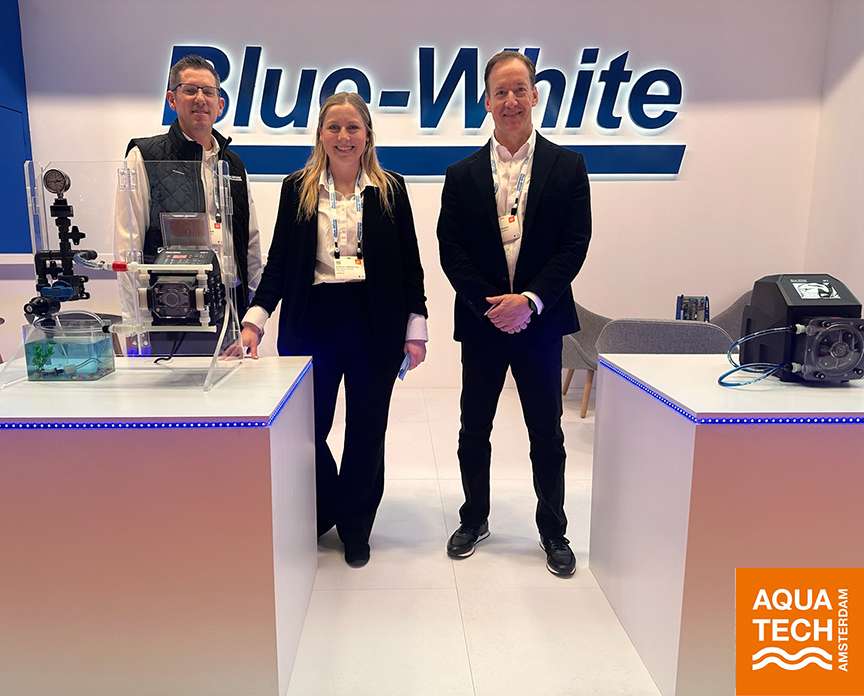
Visit BW® at Aquatech Amsterdam for Expert Chemical Dosing Solutions
Team Blue-White® is at Aquatech Amsterdam and ready to discuss the Best
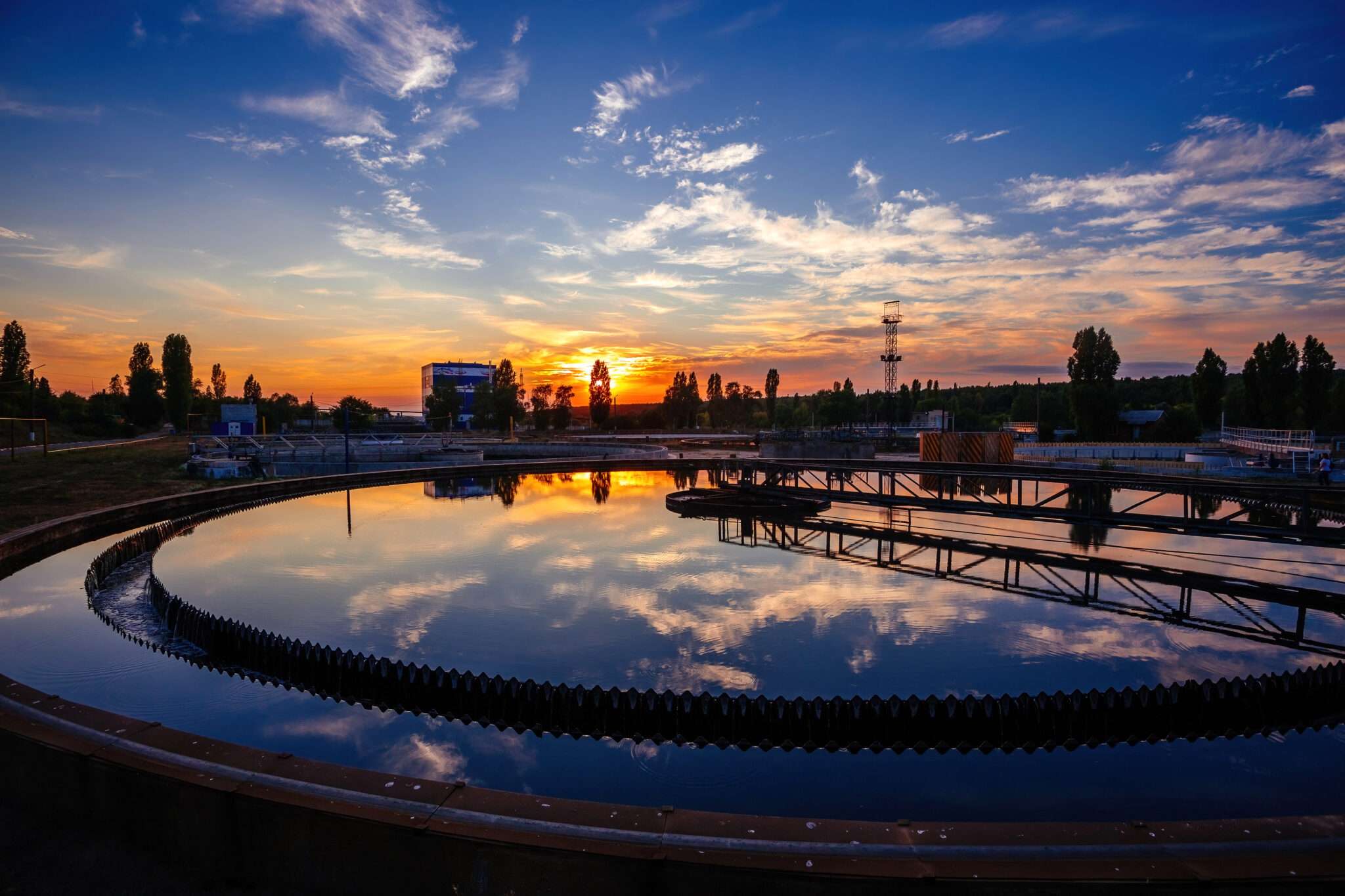
A variety of challenging chemicals are often needed in order to meet treatment goals for drinking or wastewater operations.

Some of the greatest challenges are posed by Polymers. These high viscosity fluids are used for Flocculation and Coagulation to aid in the removal of solid particles. To avoid common problems experienced with these materials, it is crucial to use a pump that will precisely and gently dose long chain polymers without causing damage to them.
pH in both drinking water and wastewater must maintain certain levels to meet regulatory demands. pH is most often adjusted using chemicals such as Sulfuric Acid, Hydrochloric Acid, or Phosphoric Acid, Sodium Hydroxide, and Calcium Hydroxide. These chemicals can be caustic.
Disinfection is often achieved using Sodium-Hypochlorite, (Chlorine), or PAA, (Peracetic Acid). These are familiar chemicals to operators, but they also bring their own challenges. Both chemicals are off-gassing. Peristaltic pumps are extremely effective when dosing fluids that contain trapped gases because they are not affected by air bubbles… bubbles simply pass through the tube. There is no vapor lock and no loss of prime.
There are a number of reasons, peristaltic metering pumps are often considered the best choice for caustic, abrasive, and viscous liquids. These pumps operate using a set of rollers which compress and release a flexible tube or hose, creating a smooth peristaltic motion that gently moves delicate fluids through the pump tube without damage.
Additionally, the chemical being dosed never comes into direct contact with the mechanical components of the pump. This prevents the pump from being exposed to damaging chemicals. Even with these advantages, some metering pumps will struggle when feeding challenging fluids. Thankfully, there are innovative technologies which have simplified the process and can make metering harsh chemicals far more manageable.
Impact of viscosity. With many fluids increasing flow rate means increasing pump speeds, however, that’s not always the case with viscous fluids. Many fluids are non- Newtonian, including some polymers. In this case, speeding up the pump can actually cause the liquid to slow down and gum up the tube. This can be resolved with the use of a smart pump and flow meter combination. The flow meter can send a signal to the pump to indicate the flow rate it is registering. The pump then automatically adjusts its pace to attempt to reach the intended flow rate.
The impact of abrasive particles. Abrasive chemicals are often required in Water treatment, such as powdered activated carbon, lime slurry, alum, and sodium hypochlorite. These substances may clog pumps and / or wear out valves and hoses. This challenge can often be easily met by simply choosing a larger orifice tube which will reduce the velocity of particles. The reduction in velocity results in less clogging and less damage to tube walls.
Impact of caustic chemicals. Chemicals such as sulfuric or muriatic acid are highly reactive and can corrode or degrade pump components, including those made of metals, plastics, and elastomers. This not only causes premature wear, but can also introduce contaminants into the dosed fluids, and ultimately the water being treated. Material compatibility is important when dealing with caustic chemicals.
While challenging chemicals can be tricky for operators, there are a range of technologies that will help mitigate problems and ensure smooth, accurate, and dependable chemical dosing. A Peristaltic Metering Pump is widely considered the best option to meet these challenges.
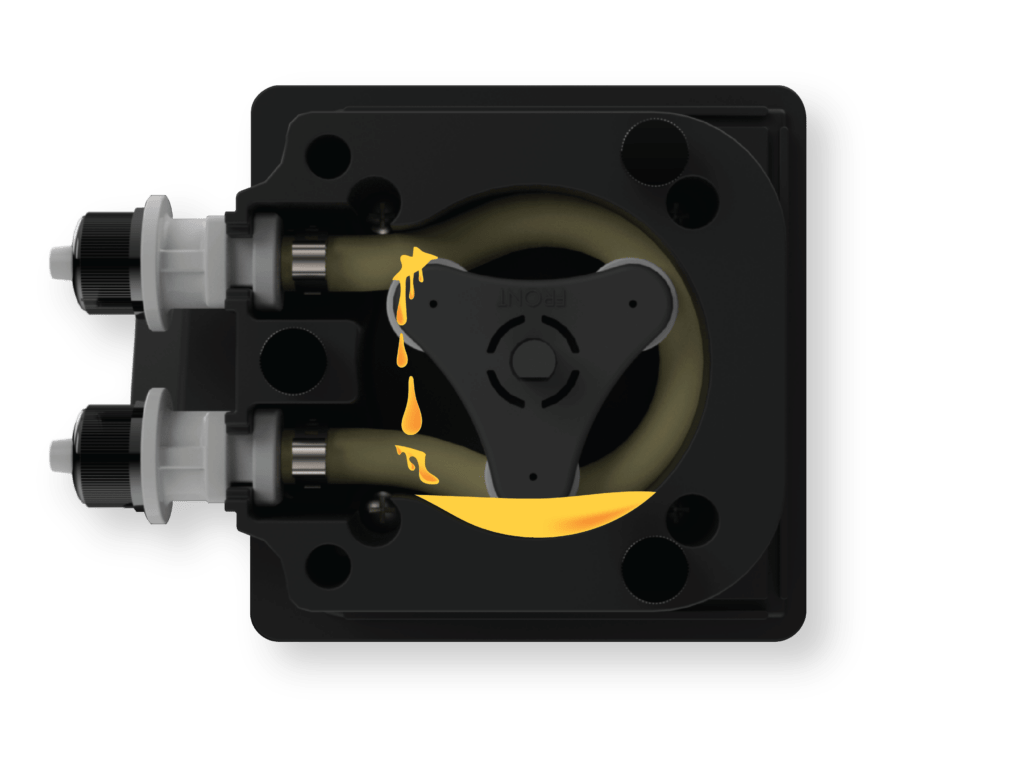
Checking for Material compatibility. As mentioned, it is important for peristaltic pump operators to choose a pump tube material that is compatible with the chemical being metered. Manufacturers generally offer a range of tube material options and should have a compatibility chart available. It pays to do the research, and discuss the challenges with the manufacturer in advance of installation and setup.
Correct Tubing Size. Larger orifice tubes can often be the simple solution when dosing highly viscous or abrasive fluids. The larger diameter makes it easier for thicker fluids to flow through the tube and reduces resistance against the tube walls.
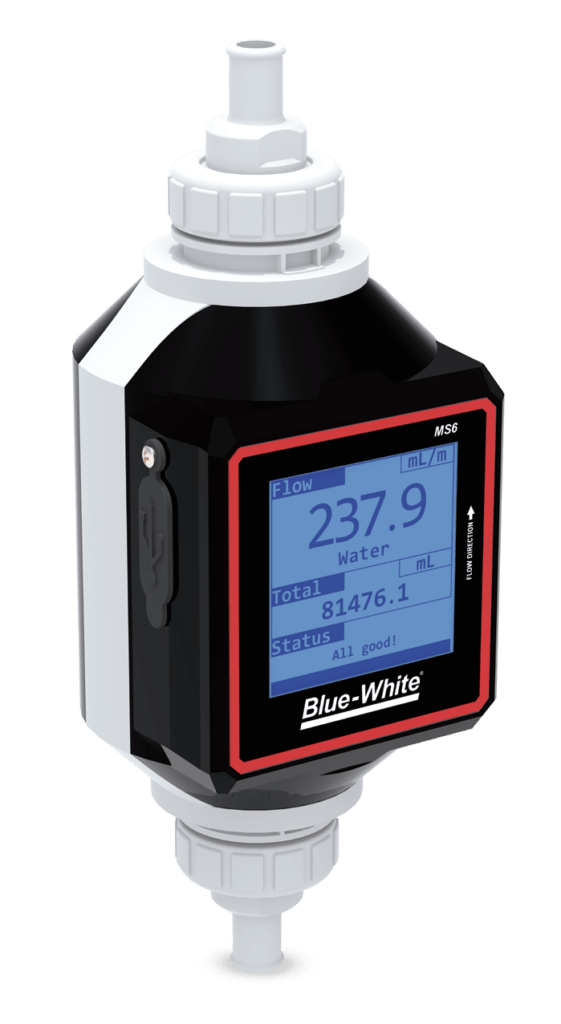
Foot Valve. Operators should consider installing a foot valve in their metering setup, or use a pump that has a foot valve strainer already built in. This will help filter out excess particles in abrasive chemicals, and/or improve flow efficiency which is helpful for handling viscous fluids.
Tube Failure Detection. One of the most important advantages when choosing a peristaltic metering pump is the isolation of the chemical being dosed from the mechanical components. However, if the tube fails, this barrier could break down, causing damage to the pump mechanism and other equipment should the leak go undetected.
For this reason, quality peristaltic pumps are equipped with a built-in tube failure detection feature which stops the pumping action when leaked fluid is detected in the pump head. Blue- White’s patented TFD System detects a wide range of conductive chemicals with no false triggering. If the TFD detects tube failure, the pump will automatically shut off and energize a relay switch. This permits communication with external equipment, such as a back-up pump or alarm. Condensation and wash down procedures should not cause false triggering.
Sophisticated Flow Meters. As mentioned above, technologically advanced flow meters can make flow calculations based on the material being metered. If dosing requirements aren’t being met, a signal will be sent to the pump to adjust its speed based on the flow rate that is trying to be achieved. This is particularly useful with viscous fluids, as well as abrasive fluids which can cause buildup within the tube and pipe walls.
Temperature Regulation. Many viscous liquids increase their flow rates as temperatures increase. This is only important for the operator to know if there is no flow instrument being used.
In conclusion, many abrasive, caustic, and viscous fluids are critical to water treatment goals. However, correct dosing of these chemicals does not have to be difficult if the correct Chemical Feed Pump is in use. With the right mix of technologies and actions, operators can effectively administer such chemicals without complication and with minimal downtime.
Written by:
Blue-White® Industries
714-893-8529

Team Blue-White® is at Aquatech Amsterdam and ready to discuss the Best
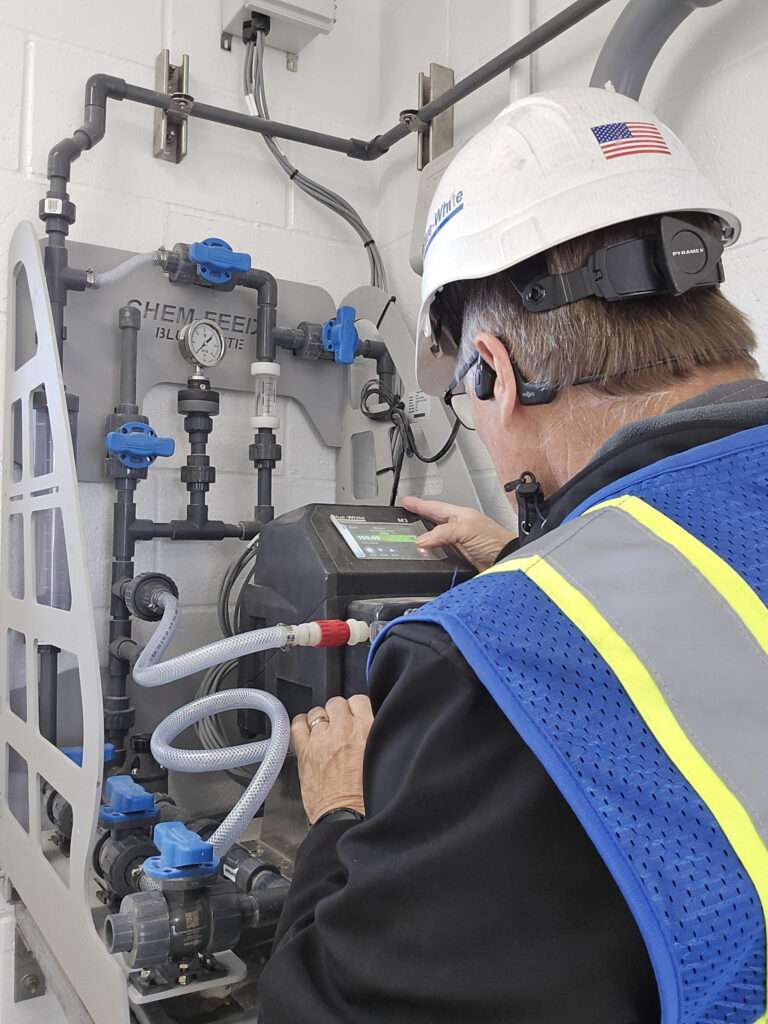
BW®’s Rich Hopkins just completed startup of this wall mount skid, equipped with Blue-White®’s
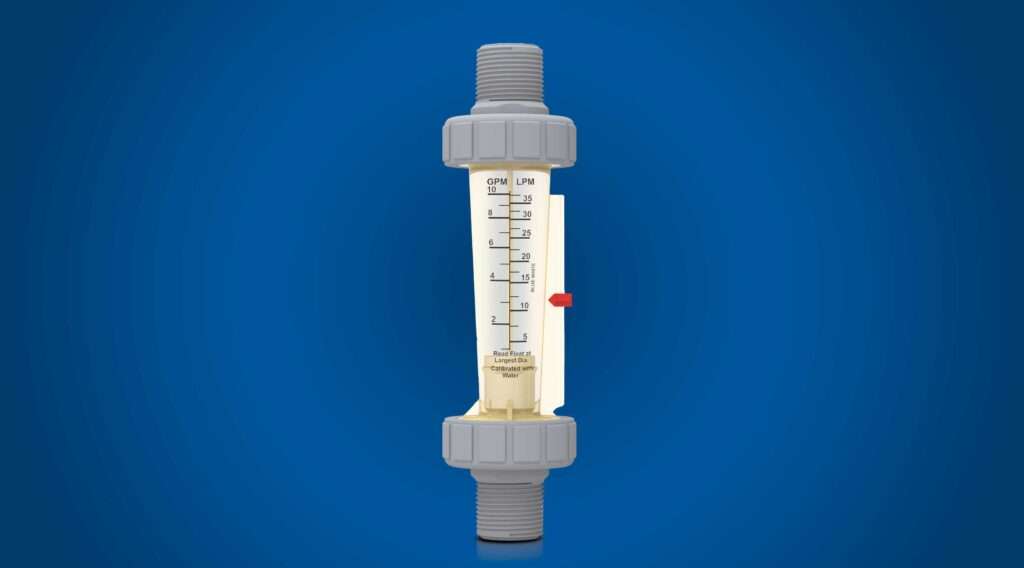
There are many industrial and municipal applications where accurately measuring fluid flow
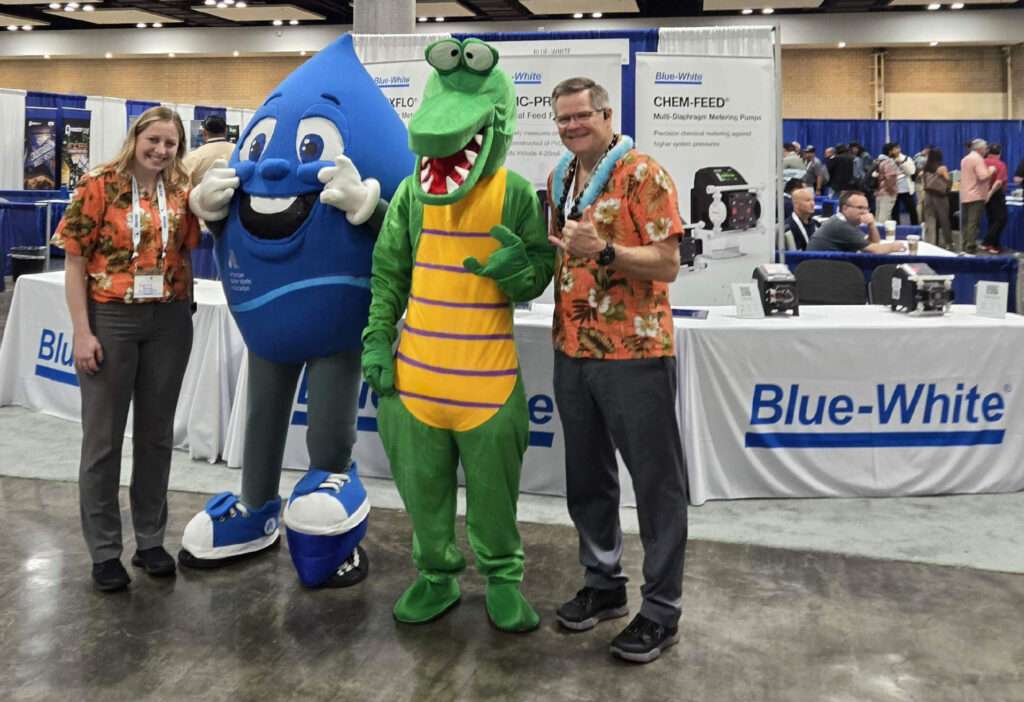
It was a busy few days in Honolulu for the Pacific Water
Copyright © 2024 Blue-White
| Cookie | Duration | Description |
|---|---|---|
| cookielawinfo-checkbox-advertisement | 1 year | Set by the GDPR Cookie Consent plugin, this cookie is used to record the user consent for the cookies in the "Advertisement" category . |
| cookielawinfo-checkbox-analytics | 11 months | This cookie is set by GDPR Cookie Consent plugin. The cookie is used to store the user consent for the cookies in the category "Analytics". |
| cookielawinfo-checkbox-necessary | 11 months | This cookie is set by GDPR Cookie Consent plugin. The cookies is used to store the user consent for the cookies in the category "Necessary". |
| CookieLawInfoConsent | 1 year | Records the default button state of the corresponding category & the status of CCPA. It works only in coordination with the primary cookie. |
| elementor | never | This cookie is used by the website. It allows the website owner to implement or change the website's content in real-time. |
| viewed_cookie_policy | 11 months | The cookie is set by the GDPR Cookie Consent plugin and is used to store whether or not user has consented to the use of cookies. It does not store any personal data. |
| Cookie | Duration | Description |
|---|---|---|
| _ga | 2 years | The _ga cookie, installed by Google Analytics, calculates visitor, session and campaign data and also keeps track of site usage for the site's analytics report. The cookie stores information anonymously and assigns a randomly generated number to recognize unique visitors. |
| _gat_gtag_UA_85334924_1 | 1 minute | Set by Google to distinguish users. |
| _gid | 1 day | Installed by Google Analytics, _gid cookie stores information on how visitors use a website, while also creating an analytics report of the website's performance. Some of the data that are collected include the number of visitors, their source, and the pages they visit anonymously. |
| CONSENT | 2 years | YouTube sets this cookie via embedded youtube-videos and registers anonymous statistical data. |
| Cookie | Duration | Description |
|---|---|---|
| VISITOR_INFO1_LIVE | 5 months 27 days | A cookie set by YouTube to measure bandwidth that determines whether the user gets the new or old player interface. |
| YSC | session | YSC cookie is set by Youtube and is used to track the views of embedded videos on Youtube pages. |
| yt-remote-connected-devices | never | YouTube sets this cookie to store the video preferences of the user using embedded YouTube video. |
| yt-remote-device-id | never | YouTube sets this cookie to store the video preferences of the user using embedded YouTube video. |
Please fill out the form to request a quote.
A sales rep will reach out to you.
| Image | Catalog Number | Description | Price | Buy |
|---|